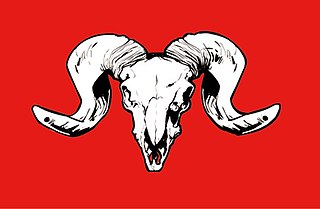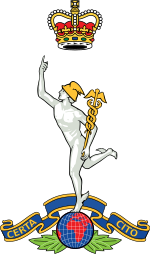The Queen's Own Warwickshire and Worcestershire Yeomanry (QOWWY) was a regiment of the Royal Armoured Corps, forming part of the Territorial Army (TA). Following reductions in 1969 and 1971 respectively the regiment was reduced to two and later one company sized sub-unit in 1999. Following a reorganisation in 2021, there are now two successors to the regiment: one squadron in the Royal Yeomanry as light cavalry, and one squadron in the 37th Signal Regiment as a support squadron.

The 2nd Signal Brigade, was a military formation of the British Army composed of Royal Corps of Signals units. The brigade was first formed following the reorganisation of the old Territorial Army in 1967, and was disbanded in 2012 under the Army 2020 programme. However, later the 2nd Signal Group was formed continuing the lineage of the old brigade, before it was disbanded in 2018.

The 31st Signal Regiment was a territorial communications regiment of the British Army's Royal Corps of Signals. The regiment first formed following the creation of the Territorial and Army Volunteer Reserve in 1967 after the 1966 Defence White Paper. After seeing limited reserve support during the Cold War, the regiment was disbanded in 2010 following the initial Army 2020 reform.

40 (Ulster) Signal Regiment (Volunteers) was a Territorial Army regiment in the Royal Corps of Signals in the British Army. The regiment formed part of 2 Signal Brigade, providing military communications for national operations. The regiment did not have an internal security role in Northern Ireland.

The 107th Brigade, later 107th (Ulster) Brigade was an infantry formation of the British Army which saw service in the First World War. The brigade was later reformed during the Cold War and finally disbanded in 2006, following the drawdown of Operation Banner.

Force Troops Command was a combat support and combat service support command of the British Army. Its headquarters was at Upavon, Wiltshire. It was formed in 2013 as a re-designation of the previous Headquarters Theatre Troops. Force Troops Command was renamed as 6th Division in August 2019.

The 1st Artillery Brigade is an operational formation of the British Army which forms part of the 3rd Division, and oversees all close support artillery units of the army. Under the Future Soldier programme, the brigade will merge with 1st Armoured Infantry Brigade to form 1st Deep Recce Strike Brigade Combat Team.

525th (Antrim) Coast Regiment, Royal Artillery (TA) was a volunteer coastal defence unit of Britain's Territorial Army from 1937 until 1956. It was the first Territorial Army unit to be raised in Northern Ireland.
The Antrim Artillery was a part-time reserve unit of Britain's Royal Artillery based in County Antrim, Northern Ireland, from 1853 to 1919. It numbered 1st on the order of precedence of the Militia Artillery. Volunteers from the unit served in the Second Boer War. During World War I it defended Belfast Lough and trained gunners for service overseas. Subsequent units continued the Antrim Artillery traditions.
3rd Anti-Aircraft Brigade was a Supplementary Reserve air defence formation of the British Army formed in Northern Ireland in 1938. On the outbreak of the Second World War it saw active service with the British Expeditionary Force during the Battle of France and Operation Aerial. It then returned to Northern Ireland and defended the Province for the next two years. Postwar, it was reformed in the Territorial Army and served until the disbandment of Anti-Aircraft Command in 1955.

The 12th Signal Brigade, later 12th Signal Group was a military communications formation of the British Army commanding regiments of the Royal Corps of Signals. Initially formed in 1967, the brigade would provide rear defence communications for the British Army of the Rhine until its disbandment in 1992. In 2004, the group was reformed to provide territorial army and rear support to the Allied Rapid Reaction Corps in Germany. However, in 2009 the group was disbanded following reductions to the Royal Corps of Signals and Territorial Army.
The 74th Engineer Regiment was a former Territorial Army regiment of the Royal Engineers, British Army. Initially the 74th Engineer Regiment was a reserve engineer regiment, but was then disbanded in 1994. An independent squadron remained. As part of Army 2020 the squadron moves to become part of the 71st Engineer Regiment.
The Glamorgan Fortress Royal Engineers was a Welsh Territorial Army (TA) unit of Britain's Royal Engineers, first raised in 1885 as a Volunteer unit of Submarine Miners to defend the Severn Estuary. During World War I it carried out defence work in England and Gibraltar, and detachments served on the Western Front. In World War II it served in the North African campaign, including the Second Battle of El Alamein, and the Allied invasion of Sicily. Postwar, the unit continued in the TA until 1961.

The Antrim Fortress Royal Engineers was a coast defence unit of the UK's Territorial Army formed in Northern Ireland in the late 1930s. During World War II it was converted to a parachute role and dropped into Normandy on D Day and across the Rhine during Operation Varsity. Its successors continue in the Army Reserve today.

43 (Wessex) Signal Regiment was a Territorial Army (TA) unit of the British Army's Royal Corps of Signals from 1920. It had its origins in a Volunteer unit of the Royal Engineers formed in the West Country in 1860. provided the communications for the 43rd (Wessex) Infantry Division during World War II. Its successor still serves as a squadron in today's Army Reserve.

102nd Heavy Anti-Aircraft Regiment, Royal Artillery, was an air defence unit of Britain's Territorial Army (TA) formed at Antrim, Northern Ireland, during the period of international tension leading up to the outbreak of World War II. It defended Belfast and its shipyards during the early part of the war and then served in the Middle East. The regiment continued in the postwar TA until amalgamated in 1955.

Kimberley Barracks is a military installation on Deepdale Road in Preston in Lancashire, England PR1 6PR.

Central Volunteer Headquarters, Royal Corps of Signals is a special administrative group of the Royal Corps of Signals formed to oversee the national reserve units of the corps.

299 Parachute Squadron, Royal Engineers is a specialist field engineer squadron of the British Army's Corps of Royal Engineers and the only reserve parachute unit of the corps. Formed in 1947 as an airborne field squadron, 299 Para Sqn would see many reorganisations and new roles, until 2006 when it took on the parachute role it maintains today. As of 2021, it is the only reserve parachute-trained squadron of the Royal Engineers.

The 9th Special Communications Unit, later redesignated as the 92nd Signal Regiment, and from 1967 as 2 Signal Squadron is a communications unit of the British Army, belonging to the Royal Corps of Signals.










